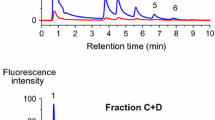Abstract
Three kinds of lake plankton were cultivated, and the properties of protein-like fluorophores released from the plankton were characterized using sodium dodecyl sulfate-polyacrylamide gel electrophoresis (SDS-PAGE). The results were compared with those by gel chromatography with a fluorescence detector and three-dimensional excitation-emission matrix (3-DEEM). The concentrated protein-like fluorophores of algal dissolved organic matter (DOM) were successfully separated from the fulvic-like fluorophores, and analyzed using SDS-PAGE. SDS-PAGE analysis revealed that the protein-like fluorescence DOM released from Microcystis aeruginosa consisted of proteins with molecular weights of 17, 37, 50, 75, 150 kDa, and greater than 250 kDa. The results of SDS-PAGE were consistent with those of gel chromatography. Those substances with molecular weights greater than 250 kDa may be a polysaccharide-peptide complex, called peptidoglycan, which is a component of bacterial cell walls. The molecular weights of protein-like fluorescence DOM from Staurastrum dorsidentiferum were determined to be 37 and 50 kDa. For Cryptomonas ovata, its DOM was found to be composed of substances with molecular weights of between 10 and 150 kDa. The results by high-performance size exclusion chromatography with chemiluminescent nitrogen detection (HPSEC/CLND) analysis suggest that the proteinlike fluorophores from the plankton might be composed of substances containing organic nitrogen.
Similar content being viewed by others
References
Shiga Prefecture, Kankyohakusyo, 2011, 42.
K. Hayakawa, Org. Geochem., 2004, 35, 169.
K. Hayakawa, Research Report of Lake Biwa Environmental Research Institute, 2005, 22, 161.
K. Amano, K. Matsumoto, A. Imai, and K. Matsushige, Jpn. J. Limnol., 2004, 27, 659.
H. Tatsumoto, T. Hattori, T. Furukawa, I. Ikushima, M. Kurihara, and I. Abe, Nippon Kagaku Kaishi, 1991, 852.
A. Imai, T. Fukushima, K. Matsushige, T. Inoue, and T. Ishibashi, Jpn. J. Limnol., 1998, 59, 53.
T. Hori, Y. Sugiyama, and M. Sugiyama, Jpn. J. Limnol., 1998, 59, 39.
Y. Sugiyama, M. Sugiyama, and T. Hori, Limnology, 2000, 1, 171.
Y. Sugiyama and T. Kumagai, Anal. Sci., 2001, 17, 77.
P. A. Raymond and J. E. Bauer, Limnol. Oceanogr., 2001, 46, 655.
S. E. Ziegler and S. L. Brisco, Hydrobiologia, 2004, 513, 153.
C. Kim, Y. Nishimura, and T. Nagata, Limnol. Oceanogr., 2006, 51, 70.
K. Maki, C. Kim, C. Yoshimizu, I. Tayasu, T. Miyajima, and T. Nagata, Limnology, 2010, 11, 143.
E. Yamada, T. Ozaki, and M. Kimura, Anal. Sci., 1998, 14, 327.
E. Yamada, K. Doi, K. Okano, and Y. Fuse, Anal. Sci., 2000, 16, 125.
S. Aoki, Y. Fuse, and E. Yamada, Anal. Sci., 2004, 20, 159.
K. Nagai, S. Aoki, Y. Fuse, and E. Yamada, Bunseki Kagaku, 2005, 54, 923.
C. Yoshimizu, T. Yoshida, M. Nakanishi, and J. Urabe, Limnology, 2001, 2, 37.
S. Aoki, S. Ohara, K. Kimura, H. Mizuguchi, Y. Fuse, and E. Yamada, Anal. Sci., 2008, 24, 389.
S. Aoki, S. Ohara, K. Kimura, H. Mizuguchi, Y. Fuse, and E. Yamada, Anal. Sci., 2008, 24, 1461.
S. Ohara, T. Uehara, K. Kimura, T. Yoshida, S. Fujiwara, Y. Mizuguchi, Y. Fuse, and E. Yamada, Bunseki Kagaku, 2009, 58, 231.
E. Fujinari and J. Damon, J. Chromatogr., A, 1997, 763, 323.
M. Morizumi and T. Matsunaga, Soil Sci. Plant Nutr., 2011, 57, 185.
D. Corens, M. Carpentier, M. Schroven, and L. Meerpoel, J. Chromatogr., A, 2004, 67, 1056.
W. Amelung, J. Plant. Nutr. Soil, 2003, 166, 677.
C. W. K. Chow, M. Drikas, J. House, M. D. Burch, and R. M. A. Velzeboer, Water Res., 1999, 33, 3253.
M. Z. B. Alam, M. Otaki, H. Furumai, and S. Ohgaki, Water Res., 2001, 35, 1008.
T. Takaara, D. Sano, H. Konno, and T. Omura, Wat. Sci. Technol-Water, 2004, 4, 95.
S. Ishifuji, Y. Sato, H. Imae, T. Takaara, D. Sato, Y. Masago, and T. Omura, J. Jpn. Soc. Wat. Environ., 2010, 33, 73.
S. Ohara, T. Uehara, S. Aoki, Y. Fuse, and E. Yamada, Abstracts of 58th Conference of the Japan Society for Analytical Chemistry, 2009, 25.
Author information
Authors and Affiliations
Corresponding author
Rights and permissions
About this article
Cite this article
Yamada, E., Hirota, T., Hatori, N. et al. Characterization of Protein-like Fluorophores Released from Lake Phytoplankton on the Basis of Fractionation and Electrophoresis. ANAL. SCI. 28, 595–600 (2012). https://doi.org/10.2116/analsci.28.595
Received:
Accepted:
Published:
Issue Date:
DOI: https://doi.org/10.2116/analsci.28.595




